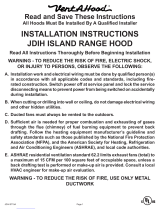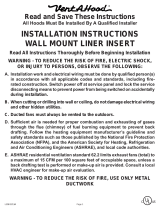Page is loading ...

Page 1L113 0516A
U
L
CUS
R
Read and Save These Instructions
All Hoods Must Be Installed By A Qualied Installer
INSTALLATION INSTRUCTIONS
EUROLINE/EUROLINE PRO
ISLAND RANGE HOOD
Read All Instructions Thoroughly Before Beginning Installation
WARNING - TO REDUCE THE RISK OF FIRE, ELECTRIC SHOCK,
OR INJURY TO PERSONS, OBSERVE THE FOLLOWING:
A. Installation work and electrical wiring must be done by qualied person(s)
in accordance with all applicable codes and standards, including re-
rated construction. Switch power o at service panel and lock the service
disconnecting means to prevent power from being switched on accidentally
during installation.
B. When cutting or drilling into wall or ceiling, do not damage electrical wiring
and other hidden utilities.
C. Ducted fans must always be vented to the outdoors.
D. Sucient air is needed for proper combustion and exhausting of gases
through the ue (chimney) of fuel burning equipment to prevent back
drafting. Follow the heating equipment manufacturer’s guideline and
safety standards such as those published by the National Fire Protection
Association (NFPA), and the American Society for Heating, Refrigeration
and Air Conditioning Engineers (ASHRAE), and local code authorities.
E. ASHRAE residential ventilation standard 62.2 limits exhaust fans (total) to
a maximum of 15 CFM per 100 square feet of occupiable space, unless a
back drafting test is performed or make-up air is provided. Consult a local
HVAC engineer for make-up air evaluation.
WARNING - TO REDUCE THE RISK OF FIRE, USE ONLY METAL
DUCTWORK

Page 2L113 0516A
Ducting Do’s and Don’ts
YES
NO
Smooth Duct
Smooth Gradual Turn
Flexible Duct
Sharp Angled Turns
General Requirements
• Observe local codes regarding special duct requirements and placement of duct against combustibles.
• UsingVent-A-Hoodtransitions(backpage)willensurepropereciency.
• UsingVent-A-Hoodroofjacksorwalllouvers(backpage)willensurepropereciency.
• Where possible, seal joints with duct tape.
• The hood must be ducted to the outdoors without restrictions.
Blower Requirements
• The island dual blower unit (T200) requires 8” round duct or equivalent (50 square inches), and the
island cluster blower unit (T400) requires 12” round duct or equivalent (113 square inches).
Blower Combined Duct Dize Sq. Inch Area Vent-A-Hood Transition
Island Dual (T200) 8" round or equivalent 50 sq. in. VP565 (Included)
Island Cluster (T400) 12" round or equivalent 113 sq. in. VP564 (Included)
Ducting Requirements
• NEVER reduce the duct size.
• Donotuseexibleorcorrugatedduct.Thistypeofductwillrestrictairowandreduceperformance.
• Onlyusesmooth,galvanized,metalduct.
• Make the duct run as short and as straight as possible with as few turns as possible.
• Avoid sharp-angled turns. Instead, use smooth, gradual turns such as adjustable elbows or 45 degree
angled turns.
• Forductrunsover20feet,increasetheductdiameterbyoneinchforeverytenfeetofduct.
• A 90 degree elbow is equal to 5 feet of duct.
Termination Requirements
• Airowmustnotberestrictedattheendoftheductrun.
• A wall louver or roof jack is required for each duct run.
• Everywalllouverorroofjackmustincludeagravitydampertopreventbackdrafts.
• Do not use screen wire or spring-loaded doors on wall louvers or roof jacks.
• Donotterminateventingintoanatticorchimney.

Page 3L113 0516A
1 ½”
1 ½”
Island Duct Cover
Mounting Holes
(Top View)
⁄” Dia.
Installation Details
1) Read all instructions thoroughly before beginning installation. Note: These instructions apply to standard hoods only.
Custom hoods may require additional specication consideration.
2) When installing an island range hood, it is recommended that the bottom edge of the hood be located no more than
30” above the cooking surface for optimum performance.
3) Load-bearing framework in the ceiling is necessary for the installation of an island hood.
Additional framework construction may be required. Do not attach an island hood to a structure
that cannot support twice the weight of the hood.
If applicable, remove the duct cover from its packaging and remove the hood-mounting
screws from the base of the duct cover. Install the duct cover to the load-bearing framework
in the ceiling using appropriate hardware through the four inside corner mounting anges
on the top of the duct cover.
4) Install the duct from the outside of the home down to the location of the exhaust outlet on the top of the transition plus
1”. This will allow the transition to engage 1” inside of the duct. Consult the connection diagrams (on next page) for
further details on exhaust outlet placement.
Use duct tape to seal all joints. A complete listing of available Vent-A-Hood ducting materials is listed on the back page
of this instruction sheet.
Transition heights are as follows:
Island Dual Blower (T200): 8” round duct connects to 9” tall VP565 transition (included).
Island Cluster Blower (T400): 12” round duct connects to 11 1/4” tall VP564 transition (included).
5) Prepare a protective surface on the oor or countertop for the hood. Remove the hood from its packaging and place
it upside-down on the protective surface for access to the inside of the hood.
Shown with duct cover installed (sold separately).

Page 4L113 0516A
Centerline
Of Hood
5" x 16"
Exhaust
Opening
8" Transition
Opening
Centerline
Of Hood
Vent Holes
Electrical
7 ¾"
12" Transition
Opening 2 ¼”
Above Top of
Hood
8” Blower
Outlets
Centerline
of Hood
Centerline
of Hood
Vent Holes
Electrical (2)
7 ¾”
10 ½”
9"
16"5"
8" Round 8" Round
2 ¼”
18”
18"
12" Round
12" Round
11 ¼"
8" Round 8" Round 8" Round
Installation Details Continued
Connection Diagram (48”- 66” Widths)
Connection Diagram (36”- 48” Widths)
550 CFM T200 Dual Blower
(Top View)
1100 CFM T400 Dual Blowers
(Top View)
Transition Installed
(Side View)
VP565 Standard Transition
(Included)
VP564 Standard Transition
(Included)
Transition Installed
(Side View)
6) Remove the shipping tape that is securing the E-Z Clean shields inside the hood. Remove the E-Z Clean shields by
lightly pulling each toward the end of the hood. Gently close the back draft dampers from the top side of the hood. To
remove the blower housings, unsnap the suitcase latches (one on each side of the housing). The housings should be
pulled forward and gently “tipped” to clear the blower wheels and then out of the hood.
Warning: Make sure power is o and locked at the service disconnecting
means on the service panel during installation.
7) Remove the blower deck assembly by removing the 12 screws around the blower mounting plate. Unplug the electrical
connector(s) and set the blower assembly aside, taking care not to damage the blower wheels.
8) Install an appropriate 1/2” UL listed electrical wire clamp through the electrical strap(s) on top of the hood deck. Install
electrical wiring from the service panel to the hood location for each blower assembly. Consult the connection diagrams
(above) for further details on electrical placement. Support the hood beneath the location where it will hang and feed
the electrical wire(s) into the wire clamp(s). Tighten the wire clamp(s).

Page 5L113 0516A
Installation Details Continued
9) Raise the hood to its nal position and attach it to the load-bearing framework in the ceiling using appropriate hardware
or to the duct cover using the screws previously removed in Step 3.
10) From inside the hood, using UL listed wire nuts, attach the “neutral” wire(s) to the white lead(s), the “hot” wire(s) to
the black lead(s), and the ground wire(s) to the green lead(s).
Warning: Do not operate hood without proper ground connection.
11) Attach the transition to the blower deck assembly and seal with duct tape. The transition must t inside the exhaust
collar on the blower deck assembly. Reconnect the electrical connector(s). For assemblies with two connectors, connect
the right harness to the front connector and the left harness to the back connector. While taking care to properly align
the duct connection between the transition and the duct in the ceiling, reinstall the blower deck assembly into the
hood using the 12 screws previously removed in Step 7.
12) Replace the blower housings and the blower shields. Make sure that the dampers open and close smoothly.
13) Refer to Owner Maintenance Guide Operating Instructions for proper hood operation. Test all blower and light functions
to ensure they are operating properly.
Model Volts Amps Hz RPM
CFM
Equivalent CFM
•
CFM
CFM
CFM
Minimum Round
Duct Size
Sones
#
T200 Island Dual 115 4.0 60 1550 550 900 507 471 431 8" (50 in.
2
) 6.0
T400 Island Cluster 115 7.5 60 1550 1100 1800 998 855 774 12" (13 in.
2
) 6.4
• BecausetheMagicLung
®
blowerusescentrifugalltrationratherthanconventionalbafeormeshlters,theMagicLung
®
blowercanhandlecookingequipmentwithhighercubicfeetperminute(CFM)requirementsandcandeliverequivalentCFMmuchmore
efcientlythanotherltrationsystems.WhencomparingtheMagicLung
®
withotherblowerunitsmadebyothermanufacturers,usethe“EquivalentCFM”.
#
RatingsinaccordancewiththeStandardTestCodebytheEnergySystemsLaboratoryoftheTexasEngineeringExperimentStation.

Page 6L113 0516A
VENTING ACCESSORIES
6” RECTANGULAR DUCT PIPE
MODEL DIM
VP507 6” x 8 ½”
24”
8 ½”
6”
ROUND DUCT PIPE
MODEL DIM
VP500
VP501
VP502
6” Round
7” Round
8” Round
36”
6”
7”
8”
3 ¼” RECTANGULAR DUCT PIPE
MODEL DIM
VP504
VP505
VP506
3 ¼” x 10”
3 ¼” x 12”
3 ¼” x 16”
30”
10”
12”
16”
3 ¼”
OFFSET L & R TRANSITION
FOR ISLAND BLOWERS
MODEL DIM
VP542
VP543
Top Left
Top Right
8”
12”
5”
16”
SIDE VENT TRANSITION L & R
FOR ISLAND BLOWERS
MODEL DIM
VP544
VP545
Left Side
Right Side
19”
8”
16”
5”
OFFSET KIT - RECTANGULAR
MODEL DIM
VP550 6” Rnd to 3 ¼” x 10”
16”
11”
6”
11”
3 ¼”
10”
STANDARD ISLAND TRANSITION
MODEL DIM
VP565 5” x 16” to 8”
8”
9”
16”
5”
CLUSTER BLOWER TRANSITION
MODEL DIM
VP564 8” & 8” to 12”
18 ½”
12”
11 ¼”
“Y” TRANSITION
MODEL DIM
VP517
VP518
VP551
8” & 8” to 12”
6” & 8” to 12”
6” & 8” to 10”
18”
10”
12”
3 ¼” x 10” BACK VENT ELBOW
MODEL DIM
VP559 3 ¼” x 10”
4 ¼”
10”
14”
3 ¼”
3 ¼”
MULTI-BLOWER TRANSITION
MODEL DIM
VP562
VP563
6” & 8” to 10”
8” & 8” to 12”
VP562 - 17 ½”
VP563 - 16 ½”
10”
12”
VP562 - 23 ¼”
VP563 - 30 ½”
3 ¼” x 10” TO 7” TRANSITION
MODEL DIM
VP521 3 ¼” x 10” to 7”
7”
7 ½”
3 ¼”
10”
LOW PROFILE ROOF JACK
(MAXIMUM 4/12 PITCH)
MODEL DIM
6 ½”
VP539
VP540
VP541
6” Round
7” Round
8” Round
16 ¾”
16 ¾”
LOW PROFILE ROOF JACK
(MAXIMUM 4/12 PITCH)
MODEL DIM
10 ½”
VP552
VP553
10” Round
12” Round
22 ½”
20 ¾”
ADJUSTABLE ELBOW
MODEL DIM
VP513
VP514
VP515
6” Round
7” Round
8” Round
6”
7”
8”
VP513 - 8 ½”
VP514 - 9 ⁄”
VP515 - 10 ⁄”
BACK/SIDE VENT ELBOW
MODEL DIM
VP561 8” to 6” x 8 ½”
12”
6”
16”
8” Round
8 ½”
WALL LOUVER
MODEL DIM
6”
7”
8”
8 ⁄”
VP526
VP527
VP528
6” Round
7” Round
8” Round
Back
View
1 ½” Flange
WALL LOUVER
MODEL DIM
11”
11”
VP554 10” Round
Back
View
1 ½” Flange
WALL LOUVER
MODEL DIM
13”
13”
VP555 12” Round
Back
View
1 ½” Flange
RECTANGULAR WALL LOUVER
MODEL DIM
3 ¼”
10”
VP538
VP560
6” x 8 ½“
3 ¼” x 10”
8 ½”
6”
1 ½” FLANGE
2” FLANGE
OFFSET KIT - ROUND
MODEL DIM
VP529 6” Rnd to 7” Rnd
16”
11”
6”
7”
10 ½”
LOW PROFILE ROOF JACK
(MINIMUM 4/12 PITCH)
MODEL DIM
10 ½”
VP552-HP
VP553-HP
10” Round
12” Round
22 ½”
20 ¾”
M1200 STANDARD TRANSITION
MODEL DIM
VP566 21” x 8” to 10”
10”
9”
8”
21”
LOW PROFILE ROOF JACK
(MINIMUM 4/12 PITCH)
MODEL DIM
6 ½”
VP539-HP
VP540-HP
VP541-HP
6” Round
7” Round
8” Round
16 ¾”
16 ¾”
/



